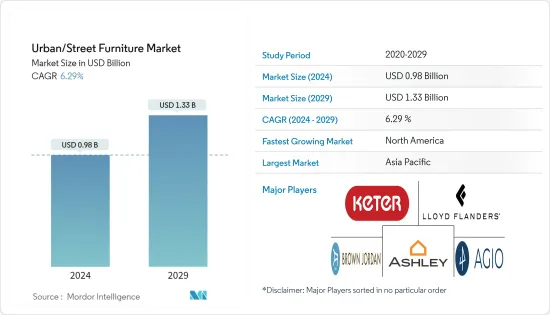PUBLISHER: Mordor Intelligence | PRODUCT CODE: 1521549

PUBLISHER: Mordor Intelligence | PRODUCT CODE: 1521549
Urban/Street Furniture - Market Share Analysis, Industry Trends & Statistics, Growth Forecasts (2024 - 2029)
The Urban/Street Furniture Market size is estimated at USD 0.98 billion in 2024, and is expected to reach USD 1.33 billion by 2029, growing at a CAGR of 6.29% during the forecast period (2024-2029).

The rise in urban population and increase in the real estate industry are factors for the growth of the global market. Factors like per capita and disposable income increase are essential in boosting the market. Growing tourism in seaside areas, hill stations, and other monumental places increased demand for hotels, resorts, public gardens, and open spaces, propelling the demand for street furniture. Street furniture is also used in commercial spaces. Apart from comfort, it offers uniqueness and boosts people's interest in enjoying outdoor spaces.
Street furniture products provide aesthetic and functional benefits in the commercial and residential sectors. The rising urbanization is a factor that helps in the market growth. The traffic light is a significant piece of street furniture that is important for the nation and reduces traffic accidents. It is made up of aluminum, iron, and other metal leads. As the production cost of aluminum, iron, and other metals increases, the cost of furniture production also increases, thus increasing the market's growth.
Increased demand for urban/street furniture made manufacturers expand and enlarge product distribution in the outdoor segment. Manufacturers are also trying to increase their market share by extending their business. Therefore, urbanization is the primary factor that increases the demand for street seating arrangements and other furniture equipment.
Urban/Street Furniture Market Trends
Demand For Eco-friendly Furniture Drives The Market
The rise in consumer preference for eco-friendly furniture made of bamboo in developing countries such as the United States, Canada, Mexico, and Cuba is due to the increased demand for eco-friendly furniture in the region. The popularity of eco-friendly furniture grew due to the vendors offering good quality furniture made up of eco-friendly products. Also, several non-profit associations have introduced instructions for manufacturers and suppliers to help ensure that business activities promote health, environmental equilibrium, and human well-being. Therefore, increasing demand for eco-friendly furniture will encourage the growth of the urban/street furniture market.
North America Dominates The Market
North America dominates the market due to the increased focus on urban development and high disposable income. The key participants of the market include manufacturers, suppliers, and distributors. The integration of smart features like IoT connectivity, and sensor-based functionalities of street furniture increased the demand in the market. Manufacturers in North America produce sustainable designs of furniture made of environmentally friendly materials and energy-efficient solutions. Street furniture designs can be customized, adaptable, and easy to reconfigure. Thus, these features of street furniture increase the growth of the market in the North America.
Urban/Street Furniture Industry Overview
The urban/street furniture market is fragmented. The market players created moderate barriers to new entrants, increasing buyers' bargaining power and promoting vendors to opt for penetration pricing strategies. Vendors from multinational companies manufacture a wide range of products. Vendors from medium-sized companies focus on a single product line. The major players are Keter Group, Lloyd Flanders, Brown Jordan, Ashely Industries, and Agio International Company Limited.
Additional Benefits:
- The market estimate (ME) sheet in Excel format
- 3 months of analyst support
TABLE OF CONTENTS
1 INTRODUCTION
- 1.1 Study Assumptions and Market Definition
- 1.2 Scope of the Study
2 RESEARCH METHODOLOGY
3 EXECUTIVE SUMMARY
4 MARKET DYNAMICS AND INSIGHTS
- 4.1 Market Overview
- 4.2 Market Drivers
- 4.2.1 Diverse Product Range Catering to Different Urban Needs Drives the Market
- 4.2.2 Established Distribution Networks and Partnerships Drives the Market
- 4.3 Market Restraints
- 4.3.1 High Initial Costs
- 4.3.2 Limited Space Availability for Installation
- 4.4 Market Opportunities
- 4.4.1 Technological Advancement in Urban/Street Furniture Market
- 4.5 Industry Value Chain Analysis
- 4.6 Industry Attractiveness - Porters' Five Forces Analysis
- 4.6.1 Threat of New Entrants
- 4.6.2 Bargaining Power of Buyers
- 4.6.3 Bargaining Power of Suppliers
- 4.6.4 Threat of Substitutes
- 4.6.5 Intensity of Competitive Rivalry
- 4.7 Insights on Technological Innovation in the Market
- 4.8 Impact of COVID-19 on the Market
5 MARKET SEGMENTATION
- 5.1 By Product Type
- 5.1.1 Wood
- 5.1.2 Plastic
- 5.1.3 Metal
- 5.2 By End User
- 5.2.1 Commercial
- 5.2.2 Residential
- 5.3 By Distribution Channel
- 5.3.1 Online
- 5.3.2 Offline
- 5.4 By Geography
- 5.4.1 North America
- 5.4.1.1 United States
- 5.4.1.2 Canada
- 5.4.1.3 Mexico
- 5.4.1.4 Rest of North America
- 5.4.2 Asia-Pacific Region
- 5.4.2.1 India
- 5.4.2.2 China
- 5.4.2.3 Japan
- 5.4.2.4 Australia
- 5.4.2.5 Rest of Asia Pacific Region
- 5.4.3 South America
- 5.4.3.1 Brazil, Argentina
- 5.4.3.2 Argentina
- 5.4.3.3 Rest of South America
- 5.4.4 Europe
- 5.4.4.1 UK
- 5.4.4.2 Germany
- 5.4.4.3 Italy
- 5.4.4.4 Rest of Europe
- 5.4.5 Middle East & Africa
- 5.4.5.1 South Africa
- 5.4.5.2 UAE
- 5.4.5.3 Rest of Middle East & Africa
- 5.4.1 North America
6 COMPETITIVE LANDSCAPE
- 6.1 Market Concetration Overview
- 6.2 Company Profiles
- 6.2.1 Keter Group
- 6.2.2 Lloyd Flanders
- 6.2.3 Brown Jordan
- 6.2.4 Ashely Industries
- 6.2.5 Agio International Company Limited
- 6.2.6 Street Furniture Australia Pty Ltd.
- 6.2.7 Saflow Product Pvt. Ltd.
- 6.2.8 Ozone Overseas Pvt. Ltd
- 6.2.9 Newton Brown LLC
- 6.2.10 Marshalls Mono Ltd.*
7 MARKET FUTURE TRENDS
8 DISCLAIMER AND ABOUT US




